#Rachel Crothers
Text
HE AND SHE / THE HERFORDS
1911-12 / 1917 / 1919-1920

He and She is a play in three acts by Rachel Crothers. Written in 1909, it was first produced in 1911, then again in 1912 under the title The Herfords, but did not appear on Broadway until late 1919 reverting to the title He and She.
‘He and She’ is about a husband and wife who are both trying to have careers as sculptors. They both submit work to a competition, and the wife wins over the the husband, which he does not take well. The wife ultimately decides to leave her work in order to take care of her teenage daughter who is having issues.
The play was given a reading in Carruthers hometown of Bloomington IL in the summer of 1911.
The first staging of the play premiered in Albany New York in mid-November 1911. From there, it moved to Poli’s Theatre in Meriden CT.
The play was scheduled to tour, with no Broadway aspirations, but by the end of the year, star Viola Allen was cast to take the role (She) originated by Emma Dunn. With Allen, the play now had the requisite prestige and an opening at Broadway’s Maxine Elliott’s Theatre was rumored imminent.
Just after the first of the year, the play was reported to be back in rehearsal at Daly’s Theatre in NYC produced by Liebler & Co.
By January 9th the play was headed to the Plymouth, not Maxine Elliott’s. This is when the title was changed to The Herfords, after the surnames of the he and she of the previous title.
By January 22nd, The Herfords had been diverted to Boston, opening on March 1, 1912. It then moved on to tour in other cities, as far afield as Oregon.
By the end of 1912, Crothers had moved onto to new plays: Young Wisdom, and Ourselves, both of which reached Broadway, placing He and She / The Herefords in cold storage. Broadway saw three more Crothers plays before He and She resurfaced in mid 1917.

On June 25, 1917, the "new” production premiered in Atlantic City at Nixon’s Apollo Theatre on the Boardwalk. It was produced by Harris and Cohen and starred Effie Shannon and Maclyn Arbuckle in the title roles. Several New York managers pronounced it “a fine success.” Cohan and Harris placed the play back in rehearsals with thoughts of an October Broadway opening. In early August Maclyn Arbuckle suddenly withdrew from the cast, taking an opportunity to perform with William Faversham in Shaw’s Misalliance.
Maclyn made a shrewd move because the Crothers play on Broadway in October was titled Mother Carey’s Chickens, not He and She. In November 1917 a new Crothers play premiered in Atlantic City titled Once Upon a Time. It, too, moved to Broadway and once again, He and She fell by the wayside.
In June 1919, the play resurfaced again - Crothers’ resume considerably bolstered. She now wished to act as well as write. Interestingly, the play had already been released for stock and amateur performances some time earlier.

At the start of the 1919-20 season the Shuberts announced their intention to produce He and She for Broadway, calling it a “new play.” In this production, Crothers herself took the role of Mrs. Herford (aka She), and Cyril Keightley played Mr. Herford (He), with film star Faire Binney in the mix. The role of Mrs. Herford was supposedly based on Carruthers’ mother. The play launched a pre-Broadway tryout tour in Baltimore in June 1919.
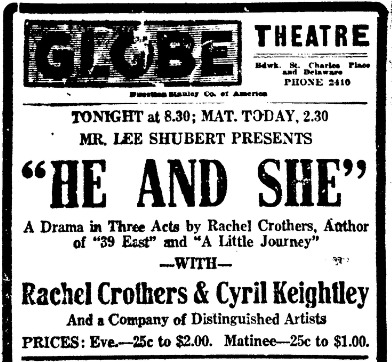
On its way to Broadway, the play stopped (again) in Atlantic City at the Globe Theatre on the Boardwalk on February 9, 1920. It moved immediately (24 hours later), to Broadway.

He and She (finally) opened on Broadway on February 12, 1920 at the Little Theatre (now the Hayes) 240 West 44th Street, Broadway’s smallest and most intimate venue
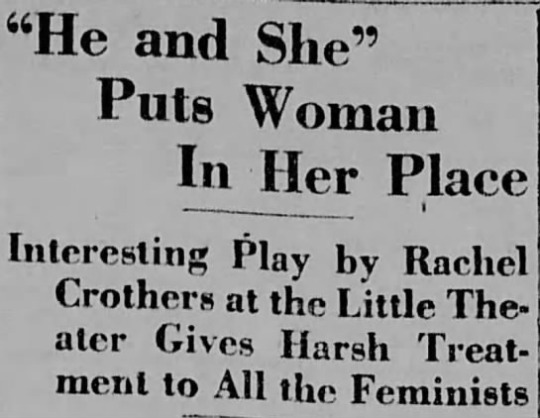
“Miss Crothers herself played pert of the artist's wife. Under strain of being author and leading lady too she was visibly nervous. In her quieter scenes she was excellent but when was called upon to played the tenser moments she played hard and hammered her lines with rather disturbing vehemence. Cyril Keightley gave an excellent performance, but the rest of the cast was not very good.” ~ HEYWOOD BRAUN
“The authoress acts well, although in the more exciting moments she is crude and overplays." ~ BROOKLYN TIMES UNION
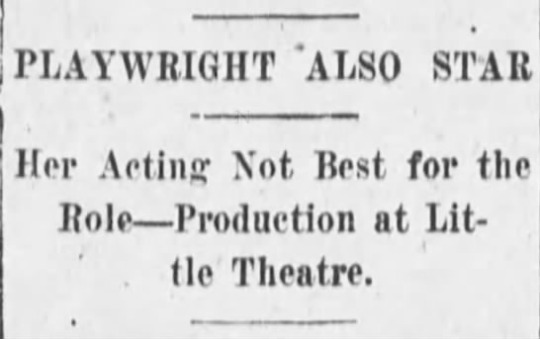
” The staleness of some of the sentiments might justify the rumor of the play's age, but It would not have been enlivening at any period.” ~ THE SUN & NEW YORK HERALD
“’He and She' seems peopled less with folks than with embodied points of view, and the play seems less a dramatic story than a symposium." ~ ALEXANDER WOOLCOT

On March 21, 1920, Crothers wrote a letter to the editor of The Tribune to take issue with the manipulation of an interview she gave with the newspaper. She claimed the author characterized her unfairly and manipulated her words about the New York critics.
He and She closed on Broadway after just 28 performances. Crothers continued to write and direct on Broadway until 1943, scoring more than a dozen more new plays but she never acted on Broadway again.
#He and She#Rachel Crothers#The Herfords#Broadway#Broadway Play#Atlantic City#Feminism#Stage#Globe Theatre#Nixon's Apollo Theatre#Little Theatre
2 notes
·
View notes
Text
The Shining Review
So for the last 3 days of October I wanted to watch some of the biggest movies on my marathon list, and put the reviews out before the others in my backlog, to sort of celebrate Halloween with a few of the more famous movies. And I began on the 29th with The Shining.
Kubrick is one of my favorite directors, disregarding who he was as a person. I’d only seen 2001 and A Clockwork Orange before this, but both of those movies completely changed my life, and I believe 2001 is the best live-action movie ever made. But yes, I’d never seen this movie from beginning to end before. Can’t call me a fake horror fan though, because I’ve seen it now :D
I’m sure everyone knows the plot – a man named Jack takes a job looking after a hotel while it closes for the cold season, takes his family with him, and goes insane from isolation and/or souls of dead people haunting the hotel. Oh, and his son Danny can telepathically communicate with people, and see the future… because it’s a Stephen King story. Duh.
The main themes people usually take away from the story are isolation, alcoholism, and child/family abuse (possibly caused by alcoholism). It also contains many hints about white peoples’ oppression of other races, and a theme of lost passion/disillusionment, which is obviously a reflection of King’s feelings of burnout with his writing at the time. Honestly, none of these themes ended up emotionally affecting me very much on first watch, but they’re still there, and the movie is such a trippy, immersive experience that it didn’t matter.
As expected, the cinematography is perfect. Every single shot has perfect composition, and the camera movement is fucking nutty. It’s my favorite aspect of Kubrick’s movies. Apparently for the scenes where Danny is riding around the hotel on his trike, Kubrick used a newly-developed camera harness to be able to film a continuous shot for so long, while being so close to the ground. The sound design in these sections is amazing too, with the sound of the wheels changing as he rolls over floor mats. There’s also lots of symmetry used in the shot composition, which cleverly expresses the 2 parallel worlds the hotel contains.
However, the thing that’s most impressive to me is how the hotel is set up – it’s literally impossible to comprehend. You’ll see characters go into a room, then later go into another room that WOULD be in the exact same spot as the other room. You’ll see hallways that don’t realistically lead anywhere, because there’s a wall or a room where they SHOULD lead. Lots of shit like that. This must’ve taken TONS of time for the set designers to plan and set up, and it’s just ridiculous how much it adds to the feeling of disorientation and liminality. And yes, this movie feels SO liminal it’s crazy. I’ve been a huge fan of liminal spaces for a long time, and NO movie I’ve seen has captured liminality as perfectly as this one does. I love how the time-jump screens jumpscare you, too.
The music is also great, done by Wendy Carlos (one of the most legendary electronic musicians ever born) and Rachel Elkind.
I’ve always gotten weird vibes from Jack Nicholson. I don’t know why, I just don’t really like the way he comes off. However, that turned out to be perfect for this movie. He’s trippy, terrifying, and pulls out an INSANE amount of technical acting ability, with some of the most expressive facial acting I’ve ever seen. So… credit where credit’s due, you weirdo.
But, then obviously there’s Shelley Duvall. I don’t say “but” because of her acting ability – she’s incredible – but her role as Wendy has become possibly the most infamous case of an actor being abused by a director, ever. Kubrick constantly screamed at her and harassed her, and even encouraged Jack Nicholson to do the same thing. Also, for the scene where Jack threatens her while they walk up a staircase, he made them do 127 takes.
It’s a little less well-known, but Kubrick was also horrible to Scatman Crothers; for the scene where his character explains Danny’s shining ability, he made them do 148 takes, and apparently it holds the record for the most takes ever shot for a single scene… I know Kubrick was VERY obsessive about quality, and in Shelley’s case all of these things might’ve been done to make her appear more exhausted/terrified for the role, but it’s completely inexcusable. Just like Tippi Hedren in The Birds, Duvall and Crothers deserve HUGE credit for delivering badass performances under those conditions.
Amazing movie. One of the most stunningly visceral, immersive experiences I’ve ever had with a work of art, just like 2001 and A Clockwork Orange. I just wish it didn’t cost Duvall and Crothers their mental health to make it.
5/5
#The Shining#Stanley Kubrick#Kubrick#Shelley Duvall#Scatman Crothers#Wendy Carlos#Rachel Elkind#horror#movies#film#horror movies#horror films#Halloween#Stephen King#The Shining 1980
0 notes
Photo

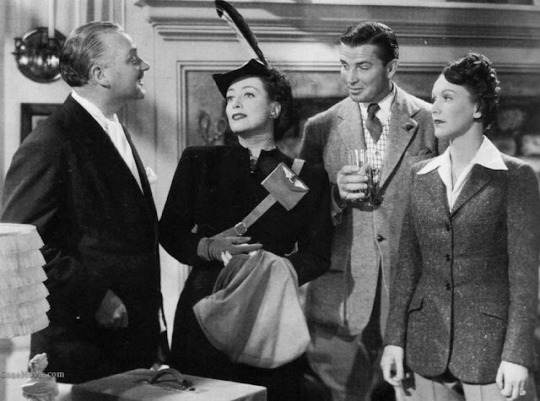

Susan and God (George Cukor, 1940)
Cast: Joan Crawford, Fredric March, Ruth Hussey, John Carroll, Rita Hayworth, Nigel Bruce, Bruce Cabot, Rose Hobart, Rita Quigley, Constance Collier, Richard Crane, Norma Mitchell, Marjorie Main, Aldrich Bowker. Screenplay: Anita Loos, based on a play by Rachel Crothers. Cinematography: Robert H. Planck. Art direction: Cedric Gibbons, Randall Duell. Film editing: William H. Terhune. Music: Herbert Stothart.
I have no hesitation in calling Joan Crawford one of the greatest film actresses of the studio era, and there's a moment in Susan and God that fully justifies my opinion. It comes at the turning point when Crawford's character, Susan Trexel, realizes how much harm her giddy self-absorption has done to her husband and daughter. In only a few seconds, surprise, guilt, and shame cross her face, and without mugging or emoting, Crawford gives each thought and emotion its due. But the moment also reveals how out of place in this sentimental comedy Crawford is: She was made for melodrama, not for frivolity, which is what the role chiefly calls upon her for. Through much of the movie, Crawford seems to be copying Rosalind Russell's performance in The Women, the movie she made with Russell and director George Cukor a year before Susan and God. In The Women, Russell played the nitwit socialite that Crawford is expected to play in Susan and God. But Susan Trexel lies outside of Crawford's established tough-as-nails persona -- which she played on to perfection in The Women -- and the later film suffers from it. It also suffers from a rather scattered script, too stuffed with secondary characters, and from a general confusion about exactly what kind of "god" Susan has found -- apparently a kind of self-help feel-good cult. Cukor keeps things moving nicely, and there are good moments from supporting players like Ruth Hussey and Marjorie Main, but it's easy to see why the film was a flop at the box office.
0 notes
Quote
The apathy of women towards women is the most dangerous thing we have to combat.
Rachel Crothers, The Importance of Being Clothed, ~1925
35 notes
·
View notes
Text


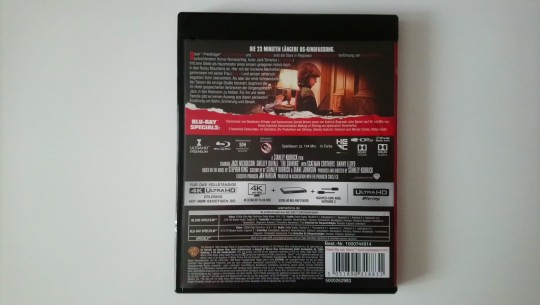

#The Shining#Stanley Kubrick#Kubrick#director#filmmaker#master#Stephen King#Diane Johnson#Ray Lovejoy#John Alcott#Wendy Carlos#Rachel Elkind#Roy Walker#Jack Nicholson#Shelley Duvall#Danny Lloyd#Scatman Crothers#redrum#overlook hotel#come play with us#here's johnny#4K#Ultra HD#HDR#2D#BD#Blu-ray#Blu-ray Disc#movie#homecinema
25 notes
·
View notes
Quote
The trained imagination of the theatre can be used for serving humanity in more ways than entertaining
Rachel Crothers, founder of the American Theatre Wing
2 notes
·
View notes
Photo

Poster by James Montgomery Flagg for Stage Women's War Relief, 1918. Stage Women's War Relief was organized at the beginning of World War I to coordinate the efforts of volunteers among women in the theater. It established workrooms for sewing uniforms and other garments (with an output totaling 1,863,645 articles), provided hospital supplies and clothing for soldiers in Europe, conducted Liberty Loan drives, arranged entertainments and stage performances for troops, and opened a canteen in 1918 for soldiers and sailors in New York City. In total, the group raised nearly $7 million for the war effort.
Shortly after the beginning of World War II, playwright Rachel Crothers, who had been one of the organizers of the original group, reestablished the Stage Women's War Relief as a branch of the British War Relief Society. They began fundraising and organizing clothing donations to send overseas to the British people and to provide relief for European refugees in America. In 1941, with the entry of the United States into the war, the organization shifted its focus to the American war effort. Its best-known effort was the Stage Door Canteen.
Picture Source: Fine Art America
#New York#NYC#vintage NY#old New York#1910s#poster#World War I#James Montgomery Flagg#illustration#Stage Women's War Relief
88 notes
·
View notes
Text
Some things that made 2021 a little more bearable....
Just a collection of movies/books/tv shows that I was into in 2021.
- “Off With Their Heads: A Serio-Comic Tale of Hollywood”, Frances Marion, 1972.
- “Black Sails”. Late to the party, but I see now why this show enjoys a vigorous afterlife on Tumblr.
- “Emily in Paris”. Pure sugar, and not memorable, but enjoyable nonetheless.
- “It’s a Sin”, which also meant that I had to rediscover my love of the Pet Shop Boys
- “The Ghost & Mrs. Muir”, 1947. I loved it so much I also read the book! The sitcom from the late 60′s was cute and didn’t shy away from the romance, but that’s about it (you can find it on YouTube, if you’re curious).
- “Laura”, 1944. Again, I loved it so much I also read the book! Dana Andrews became my new favourite leading man.
- “Gilda”, 1946. I had NO IDEA that this movie was kinky.
- “Blood and Sand”, 1941. Will never like Tyrone Power, but Rita Hayworth and Anthony Quinn have a smokin’ hot dance number. I never finished watching the 1922 version with Rudolph Valentino, but I should. Did you know that there’s also a cocktail named “Blood and Sand”?
- “The King and I”, 1956. Honestly, it’s all about the “Shall We Dance?” number. “Anna and the King” from 1999, on the other hand, was a total snooze.
- “Loki” because SYLKI!!!
- “Our Modern Maidens”, 1929. Douglas Faibanks Jr. became my new NEW favourite leading man.
- “The Thief of Baghdad”, 1922, just because I had to see how Fairbanks Senior compared.
- “Let Us Be Gay”, 1930. I will watch anything with Queen Norma Shearer, and this led me to the plays of Rachel Crothers.
- “Citizen Hearst”, “The Cat’s Meow” and “The Times We Had: My Life with W.R. Hearst” by Marion Davies. Never could understand their relationship...
- “Britannia” Season 3. There had better be a heartfelt reunion in Season 4 or Jez Butterworth will be hearing from me!
- “Downton Abbey” rewatch. Tom Branson is love, and that’s all there is to it.
#dowton abbey#tom branson#britannia#britannia tv#Britannia Season3#loki#loki tv series#gilda#the king and i#blood and sand#rudolph valentino#rita hayworth#Our Modern Maidens#Douglas Fairbanks Jr.#douglas fairbanks#let us be gay#norma shearer#Laura#dana andrews#ghost and mrs. muir#it's a sin#emily in paris#Black Sails#frances marion#marion davies#w.r. hearst#sylki
7 notes
·
View notes
Photo

1914 A play by Rachel Crothers called “Young Wisdom” played on Broadway with sisters Mabel and Edith Taliaferro as stars.
95 notes
·
View notes
Text
MARY THE 3RD
February 5, 1923
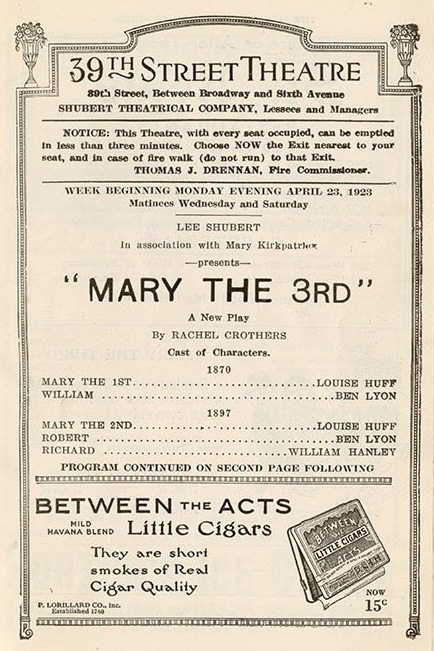
Mary the Third tells the story of three generations of women in one family, all named Mary. Louise Huff played the roles of all three Marys at the time of their courtships in a play that explores the different attitudes towards marriage of each generation.
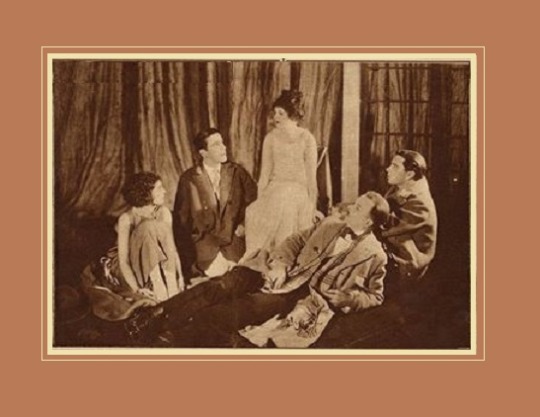
The play was performed in the Thirty-ninth Street Theater for 152 performances from February through June 1923. Above is the only known surviving photo of the play on stage.

MGM filmed Mary the 3rd as Wine of Youth in 1924. It was produced and directed by King Vidor and starred Eleanor Boardman as Mary. Ben Lyon repeated his Broadway role as Lynn, but two other actors (Johnnie Walker and Niles Welch) played the other two male roles played by Lyon on stage. Jean Arthur played a flapper. Zasu Pitts had her scenes deleted from the final cut.
AUTHOR

Rachel Crothers (1878 – 1958) was a playwright and theater director known for her well-crafted plays that often dealt with feminist themes. Among theater historians, she is generally recognized as the most successful and prolific woman dramatist writing in the first part of the twentieth century. One of her most famous plays, her last of 30 on Broadway, was Susan and God (1937), which was made into a film by MGM in 1940 starring Joan Crawford.
CAST (5M / 5F)
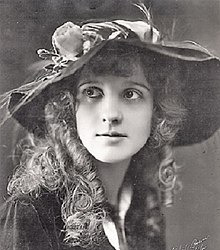
Louise Huff (Mary 1 / Mary 2 / Mary 3) was a silent screen actress who was a descendant of President James K. Polk. She started her stage career at the age of fifteen and did her first silent film in 1913 and her last in 1922, just before coming to Broadway to make her debut in Mary the 3rd. She did one more play in 1924 and came out of retirement in 1963 for the Mel Brooks film Inside Danny Baker. She died a decade later at age 77.

Ben Lyon (William / Robert / Lynn) was a film actor who did more than 70 films between 1918 and 1955. This is his only Broadway credit. He died on a cruise ship passing by Hawaii in March 1979, age 78.
REVIEW

VENUE
Although the above anonymous reviewer’s column is probably apocryphally named, the 39th Street Theatre did in fact have a second balcony (see below photo). In actuality, this would have technically called “the balcony” and the middle level the ‘mezzanine’ (an Italian word for ‘middle’). These were also known as the ‘cheap seats’ as they were naturally less expensive and (consequentially) less luxurious, perhaps without padding and having their own entrance around the side or back of the theatre. Today, few theatres with ‘second balconies’ survive. Because an Italian word seems more exotic and lacks the no-frills connotation of balconies, modern theatres often call their second level the ‘mezzanine’ although without a third level, it is technically a misnomer.
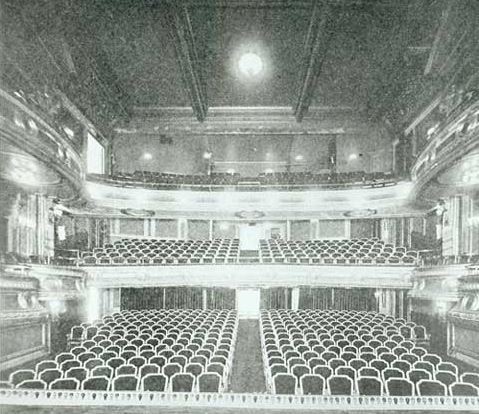
39th Street Theatre (119 West 39th Street; 700 seats) was built by the Shuberts in 1910 and opened as Nazimova’s 39th Street Theatre in order to appease the silent film actress Alla Nazimova, who was under their management. When that failed in 1911, her name was dropped from the marquee. It was the first of four homes to the Jerome Kern musical Very Good Eddie (1916). It closed with Laff That Off starring Shirley Booth in 1926 and was razed shortly afterwards to build an office building.

#Mary the 3rd#39th Street Theatre#Broadway#1923#Shubert#Ben Lyon#Louise Huff#Rachel Crothers#Wine of Youth#MGM#King Vidor#Susan and God
0 notes
Text
invisiblehoward asked: ❝ it’s us against the world. ❞ / for jb 💘

HAULED UP IN HER ROOM, and she’s glad her mom’s out at work, leaving the two of them alone to just be. they’d gotten closer over the the last couple of years, as rue faded out her life, jade was the one who was there for her, the two of them forging a friendship out of their lost friend, an sure, rue would dip in from time to time but for the most part it was just the two of them against the world, in some ways their lives a mirror, addict fathers and less than stellar moms -- but, at least suze was a cool mom, gemma was just a fucking bitch.
a grin picks up on her face at lexi’s words, it’s dope to know they’re on the same page, and while she knows she’s never a replacement for rue, she’s thankful for having her in her life, even if they seemed like unlikely friends. “ you fuckin’ know it lex --” jade grins, nerves flutter in her stomach but she tries to ignore them, and her stupid little crush. “ you’re like one the coolest people i know -- in like a dorky kinda way --” she teases laughing as she nudges her arm playfully, before she adds, “ nah but for real though -- i think this whole play things sick, you’re gonna be like a modern day Rachel Crothers or some shit.”
knowing lexi was nervous the closer it go to show week, since beside jade and fezco no one really knew what the play was about, but the way she saw it; if they didn’t like the TRUTH well, that was their problem. besides, she was kinda hopeful that maybe this might be in some weird way what rue needed, to see that she was LOVED.

“ and we’re totally celebrating when once play weeks done you and me -- however the fuck you wanna celebrate, but it’s happening!”
@invisiblehoward // euphoria meme // accepting!
#💕 ❛ i don't want you like a best friend ❜ [ jb x lexi ]#❛ you're gonna make mistakes ; you're young ❜ [ muse; jade bailey jones ]#❛ talk like an open book ; sign me up ❜ [ answered asks ]
1 note
·
View note
Text
AS HUSBANDS GO
1931

As Husbands Go is a three-act play by Rachel Crothers. It was originally produced by John Golden and staged by the author.
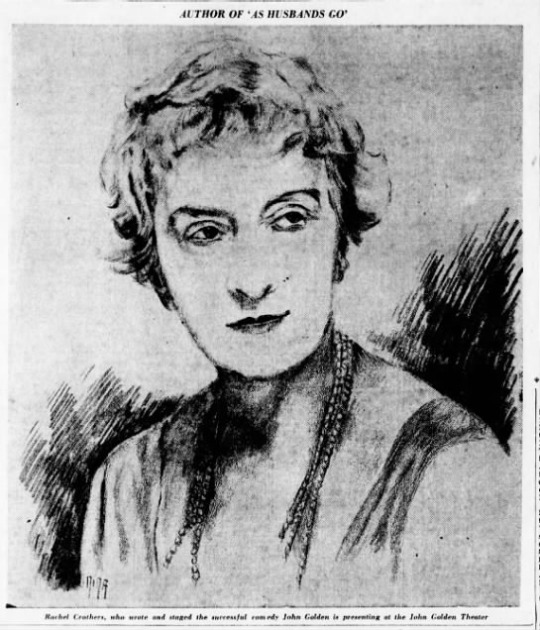
The play takes place at a café in Paris and the living-room in the Lingard House, ten miles from Dubuque, Iowa.
While in Paris, a widow from Iowa and her younger married neighbor, discover alluring gentlemen. The widow is attracted to an elderly boulevardier, while the neighbor is smitten with a handsome (and younger) English author. Instead of souvenirs, the ladies daringly bring the men back home to Iowa.
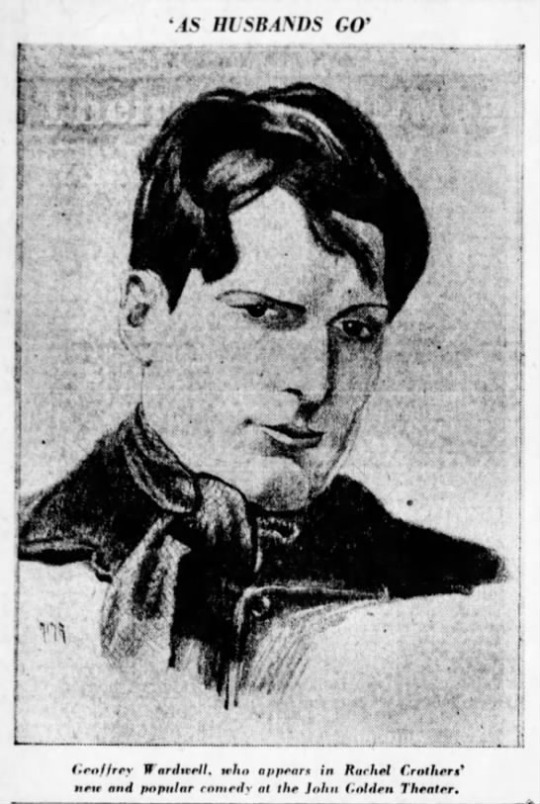
“If all husbands were as gallant as Charles Lingard in Rachel Crothers’ comedy... divorce courts could go out of business; that is, provided all wives were as delightfully tractable as pretty Lucile Lingard.” ~ BROOKLYN LIFE

For the world premiere, Golden chose Brandt’s Boulevard Theatre in Jackson Heights NY. It opened for a week’s stay on February 23, 1931.
The play premiered on Broadway at (fittingly) the John Golden Theatre on March 5, 1931. This was the first of three venues named for the producer. Located on 58th street, it stopped presenting live theatre in 1936 and was demolished in 1985. The third theatre named for Golden is now known as the Bernard Jacobs.

“If a smiling lady should be found dancing in the streets in Fifty-eighth Street, to be specific, with laurel and bay leaves in her hair, that would be Rachel Crothers. For the second time in three years she has taken advantage of John Golden's adventurous generosity and produced a hit in his name when he was no closer to it than Palm Beach, Florida. Ticket brokers, I'm told, are willing to buy all the seats the Golden office will sell for the next several weeks of ‘As Husband Go’, so sure are they that it is to be listed among the hits.”
Mantle is referring to the fact that Golden was seldom in Manhattan. In January 1931 he purchased the play from Havana, and was in Palm Beach when it finally opened.



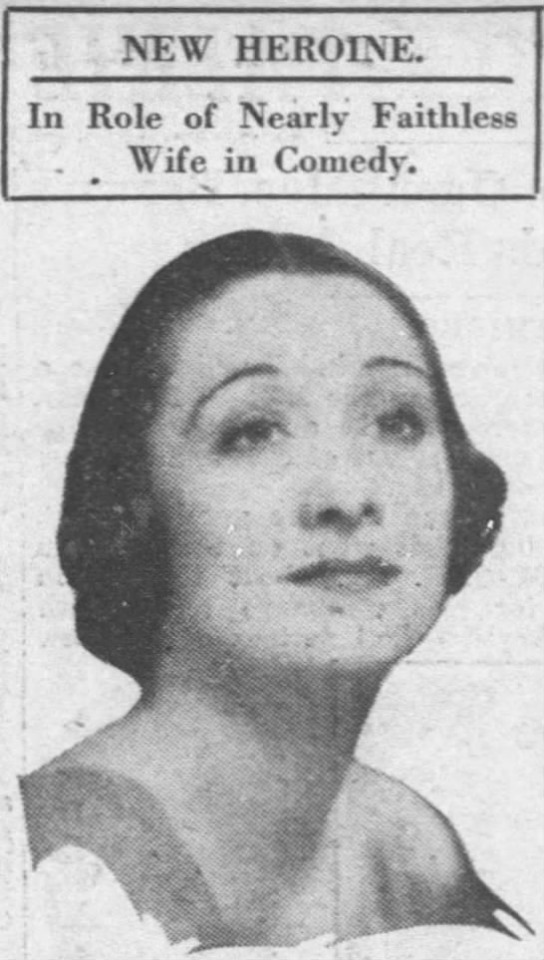
On May 4, 1931 Gloria Holden replaced Lily Cahill as Lucile Lingard. Cahill left the role suddenly for undisclosed reasons. Golden heard Holden on radio and signed her to make her Broadway debut.

The show’s 100th performance (a matinee on May 23rd) coincided with a military air show, so Golden moved the curtain time to 3:15pm to prevent audiences being distracted by the roar of aircraft motors.
At the same time in Los Angeles, producer E.E. Clive had presented a West Coast company of As Husbands Go. Clive would also produce the Broadway revival in 1933.

In late June 1931, Golden invested in some new-fangled technology - air cooling! Perhaps theatres would now be able to operate year-round? Cool!
After Independence Day, the play started to advertise “last weeks” and closed on July 11th. Golden had agreed to the play becoming one of the Theatre Guild’s subscription series. This was a consortium of cities nationwide that would share the same plays. One of those cities was Atlantic City.

Coincidentally, Clive’s California company wrapped up its run on September 12th, just as the Theatre Guild tour was preparing to launch. The production was integral in selling the play to Hollywood.

After a summer break, the play re-opened in Atlantic City at Nixon’s Apollo Theatre on the Boardwalk on September 28, 1931.
A new production, under the guidance of producers O.E. Wee and Jules J. Leventhal in mid-January. Again, Crothers provided direction. Wee and Leventhal were known as “W & L: The Revivers” with six productions in a short period of time - all revivals. Simultaneously, the play had been sold to stock and regional producers, virtually flooding the nation with Husbands!
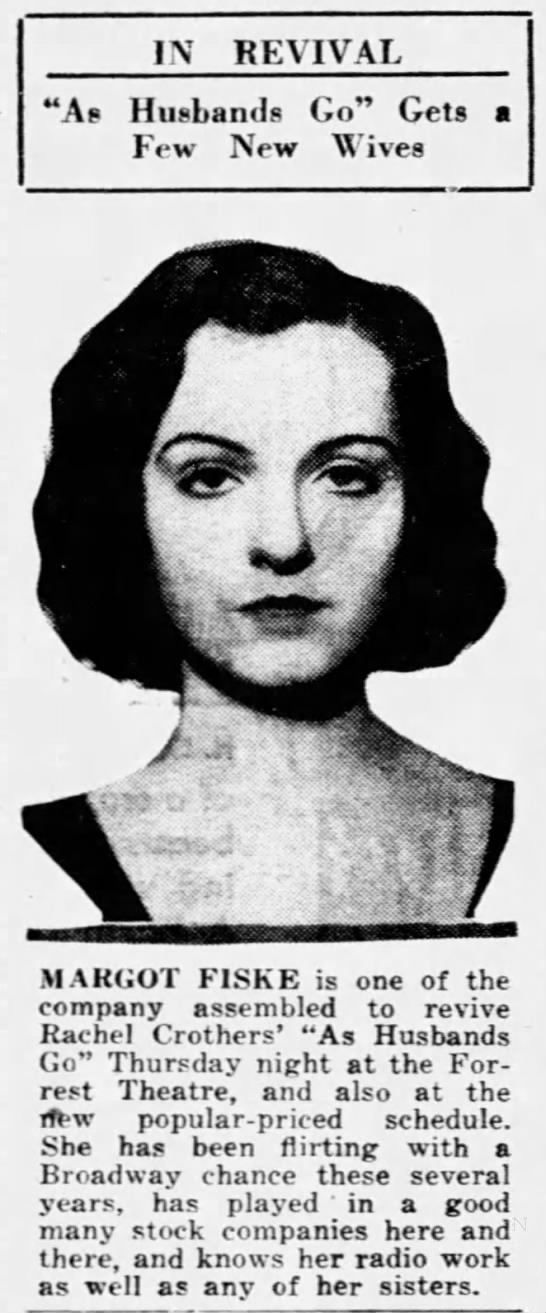
In January 1933, the play returned to Broadway at the Forrest Theatre, today known as the Eugene O’Neill. Remarkably, both the original Broadway production and the Broadway revival ran the same number of performances: 148.

In 1934, a film version was released. The screenplay was written by S.N. Behrman, Sonya Levien, and Fred Niblo Jr. and starred Warner Baxter as the titular Husband.

The film had its world premiere at the famous Steel Pier Theatre in Atlantic City on December 3, 1933, nearly two months before its general release in late January 1934.
#As Husbands Go#Rachel Crothers#1931#Broadway#Atlantic City#Broadway Play#Broadway Theatre#Nixon's Apollo Theatre#John Golden
4 notes
·
View notes
Text
May 6th 2021
The shining:
The shinning!!! 9ne of the most popular horror movies of all time! Kicked off one of the most famous memes and was an eye opener for many people. The movie steered people to go read the books and create movies simular to the shinings concept.
Quotes:
Jack Torrance: Am not going to hurt you i just want to smash your brains in.
Jack Torrance: Here's Johnny!

Plot summary:
Jack Torrance takes a winter caretaker position at the remote Overlook Hotel in the Rocky Mountains, which opened in 1909 on a Native American burial ground site and closes during the snowed-in months. Manager Stuart Ullman warns of a previous caretaker, Charles Grady, who killed his family and himself. In Boulder, Jack's son, Danny, has a premonition about the hotel, and Jack's wife, Wendy, tells a doctor about Danny's imaginary friend, Tony. When the family moves into the hotel, head chef Dick Hallorann informs Danny of a telepathic ability the two share, which he calls "shining". Hallorann tells Danny that the hotel has a "shine" and its own memories, and warns him to stay away from room 237.
A month later, Danny has frightening visions and is bruised from a ghost woman after entering the open-door Room 237 out of curiosity. Meanwhile, Jack's mental health deteriorates; he gets nowhere with his writing, is prone to violent outbursts, and has dreams of killing his family. Recovering from alcoholism following an injury of his son during a drunken rage, he gets back to his drinking habits in the Gold Room, where he encounters ghostly figures such as bartender Lloyd and waiter Delbert Grady. Grady informs Jack that Danny has reached out to Hallorann using his "talent", and says that Jack must "correct" his wife and child.
Wendy and Jack argue over whether Danny should be removed from the hotel; she begs him to leave with Danny, but the argument escalates into Jack threatening her life and Wendy knocking him unconscious with the baseball bat and locking him in the kitchen pantry. With her and Danny trapped due to the phone lines being down from a snowfall and Jack disabling the hotel's two-way radio and snowcat, Jack is freed by Grady and goes after Wendy and Danny with an Axe. Danny escapes the hotel through the bathroom window, while Wendy attacks Jack with a knife. Hallorann goes from Florida to Colorado after telepathically sensing Danny's fear, and his arrival distracts Jack. Jack ambushes and murders him in the lobby, then pursues Danny into the hedge maze, while Wendy runs through the hotel looking for Danny, encountering ghosts, a cascade of blood Danny envisioned in Boulder, and Hallorann's corpse. In the hedge maze, Danny lays a false trail to mislead Jack and hides behind a snowdrift while Jack follows the false trail. Danny and Wendy reunite and leave in the snowcat in which Hallorann arrived, leaving Jack to freeze to death in the maze. In a photograph in the hotel hallway, Jack is pictured standing amid a crowd of party revelers from July 4, 1921.
Cast:
Jack Nicholson as Jack Torrance
Shelley Duvall as Wendy Torrance
Danny Lloyd as Danny Torrance
Scatman Crothers as Dick Hallorann
Barry Nelson as Stuart Ullman
Philip Stone as Delbert Grady
Joe Turkel as Lloyd
Anne Jackson as Doctor
Tony Burton as Larry Durkin
Lia Beldam as Young Woman in Bath
Billie Gibson as Old Woman in Bath
Barry Dennen as Bill Watson
Lisa and Louise Burns as Grady Twins
Directed by:
Stanley Kubrick
Produced by:
Stanley Kubrick
Screenplay by:
Stanley Kubrick
Diane Johnson
Based onThe Shining
by Stephen KingStarring
Music by:
Wendy Carlos
Rachel Elkind
Cinematography-John Alcott
Edited -Ray Lovejoy
Production:
companies
The Producer Circle Company
Peregrine Productions
Hawk Films
Distributed by:
Warner Bros. (United States)
Columbia-EMI-Warner Distributors (United Kingdom)
Release date:
May 23, 1980 (United States)
October 2, 1980 (United Kingdom)
Running time:
146 minutes (premiere)
144 minutes (American)
119 minutes (European)
Countries
United States[5]
United Kingdom[5]
Language:English
Budget-$19 million
Box office-$47 million[6]
1 note
·
View note
Photo

The Shining (Stanley Kubrick, 1980)
Cast: Jack Nicholson, Shelley Duvall, Danny Lloyd, Scatman Crothers, Barry Nelson, Philip Stone, Joe Turkel, Anne Jackson. Screenplay: Stanley Kubrick, Diane Johnson. Cinematography: John Alcott. Production design: Roy Walker. Film editing: Ray Lovejoy. Music: Wendy Carlos, Rachel Elkind.
There are those of us who don't love The Shining. There used to be a lot more of us: When it first opened, Stanley Kubrick's movie met with lukewarm reviews and a general feeling that it was a well-made but not particularly interesting horror movie. Today, the word tossed about often is "masterpiece," and the ranking on IMDb is a whopping 8.4 out of a possible 10. But for me the film is all tricks and no payoff, and the central problem is Jack Nicholson. I know, it's an intensely committed performance, like all of his. But it's one-note crazy almost from the start, partly because the demonic eyebrows and sharklike grin are in full play. Jack Torrance should go mad, nut just be mad, and Kubrick hasn't allowed Nicholson to make the transition of which the actor is fully capable. But Kubrick is less interested in creating characters than in playing with shock effects. Shelley Duvall is forced to turn from a loving and resourceful mother to a blithering nutcase before reverting to the former by the end of the film. Then, too, there are the clichés on which the story is based: the isolated hotel built on the old Indian burying ground, the hedge maze, the kindly but obviously doomed Black man, and so on. Even the supernatural elements are muddled: What does the extrasensory communication, the "shining" of Danny (Danny Lloyd) and Halloran (Scatman Crothers), have to do with the presence of ghosts in the hotel beyond being a way to provide a rescue at the end? The film works for me only if I let myself take on some of its director's notorious cold detachment, and I want movies to let me do more than just admire technique.
0 notes
Text
5 Old Horror Movies That Were Way Ahead Of Their Time
Horror movies have been more popular than any other film genre for more than a decade. These movies are scary, fearful and include a great storyline. These nail-biting movies draw more attention of the audiences because of their stunning action and thrilling sequences. There are a lot of horror movies made in the past several years, but some of them seemed with too many upsetting tones, graphic imagery, and terrifying themes and have been considered under the category of those movies that are far ahead of their time. In this article, we have listed the five horror movies out of many horror classics that have proved to be far ahead of their time.

Freaks (1932)
The film Freaks is one of the horror classics, which was directed and produced by Tod Browning. The film stars Wallace Ford, Olga Baclanova, Roscoe Ates, and Leila Hyams in the main roles, and they portray the characters of Phroso, Cleopatra, Roscoe, and Venus, respectively. The story of the film revolves around a trapeze artist. She joins a carnival sideshow performers’ group and has a plan to seduce and kill a dwarf in the group in order to acquire his inheritance. However, the plan of trapeze artist eventually flops and leads to various dangerous consequences. The film features a group of circus performers, who are actually real-life performers, and this casting decision at that time has been considered way ahead of its time.
The Bride Of Frankenstein (1935)
Bride of Frankenstein is one of the most famous Sci-Fi horror movies, which was released in the year 1935 and directed by James Whale. It was the first sequel to the film Frankenstein that was released in the year 1931. Elsa Lanchester portrays the character of Mary Shelley and the titular character bride of Frankenstein in this film. This movie has also been considered as one of the best sequels of a real horror-comedy film. The film also boasts an early prominent female lead, and it was well-received by the viewers at that time and still gets appreciated on today’s date. The film shows a blend of horror and humor when Dr. Frankenstein, portrayed by Colin Clive, tries to create a female companion for its monster that is bolt-necked.
Diabolique (1955)
Diabolique is one of the most famous French psychological horror-thriller movies, which was released in the year 1955 and directed by Henri-Georges Clouzot. The film includes Simone Signoret, Paul Meurisse, Charles Vanel, and Véra Clouzot in the main roles and portrays the characters of Nicole Horner, Michel Delassalle, Alfred Fichet, and Christina Delassalle, respectively. When this film was released in the U.S., it received a lot of negative responses, but with the moving time, the film has been reconsidered as one of the genuine masterpieces. The story of the film revolves around a revengeful wife who plans to kill her husband along with one of his mistresses.
Night Of The Hunter (1955)
The Night of the Hunter is another famous thriller-horror film, which was directed by Charles Laughton and released in the year 1955. The film includes Robert Mitchum, Lillian Gish, and Shelley Winters in the main roles, and they portray the characters of Reverend Harry Powell, Rachel Cooper, and Willa Harper, respectively. It was the only film which was directed by an actor who also won an Oscar Award. The film has been considered as one of the best horror movies of its time as it was an incredible masterstroke in suspense and terror. The story of the film revolves around Harry Powell, who is a religious man and gets to know from a fellow prisoner that an amount of $10,000 is buried somewhere on the property of the man and it was stolen cash. The story of the film has been considered well ahead of its time.
The Shining (1980)
The Shining has been one of the most popular psychological horror films for several years. The film was released in the year 1980 and directed and produced by Stanley Kubrick. The film is a great adaptation of a novel of the same name written by Stephen King in the year 1977. It stars Jack Nicholson, Scatman Crothers, Danny Lloyd, and Shelley Duvall in the main roles, and they portray the characters of Jack Torrance, Dick Hallorann, Danny Torrance, and Wendy Torrance, respectively. This film was panned by the maximum viewers who saw the film at the time of its release, but the film was proved to be way ahead of its time as a horrific puzzle and gained huge popularity thereafter. On today’s date, this film has been considered as the all-time greatest horror film ever made.
This article concludes the five best horror classic movies that have been considered to be way ahead of their time.
Source: 5 Old Horror Movies That Were Way Ahead Of Their Time
0 notes
Text
Gingold Theatrical Group Announces 2020-'21 Speakers' Corner Writers Group

The writers are Kate Douglas, Aeneas Sagar Hemphill, Divya Mangwani, Seth McNeill, Sophie Sagan-Gutherz, and Marcus Scott.
by BWW News Desk
Nov. 19, 2020
Gingold Theatrical Group, now in its 15th Season, is continuing its new play development with the SPEAKERS' CORNER Writers Group. For the 2020-'21 season, writers Kate Douglas, Aeneas Sagar Hemphill, Divya Mangwani, Seth McNeill, Sophie Sagan-Gutherz, and Marcus Scott will develop works in response to Shaw's Arms and the Man.
Named after the corner of London's Hyde Park where George Bernard Shaw and other political speakers have delivered speeches since 1855, GTG's SPEAKERS' CORNER brings together six to ten writers each year who will spend the year exploring a specific Shaw play and writing individual new plays in response to that text and Shaw's forward thinking humanitarian ideals.
The group is led by GTG Associate Director Ilana Becker, a producer and director specializing in new play and musical development, community-driven projects, and arts education. In addition to serving as Gingold Theatrical Group's Associate Director, Ilana is The Civilians' R&D Program Director. She has served on the staff of All for One Theater, Lincoln Center Education, and Bret Adams Ltd, and spent a year as the Associate Artistic Director and Interim Artistic Director of Sun Valley Center for the Arts' Company of Fools. Ilana is a proud member of the WP Theater 2018-2020 Producers Lab, an alum of The Civilians' R&D Group, Lincoln Center Theater Directors Lab, DirectorsLabChicago, Fresh Ground Pepper PlayGroup, The Orchard Project's Liveness Lab, as well as a Playwrights Horizons Robert Moss Directing Fellow and an Emerging Leader of NY Arts Fellow. She is the creator of Argument Sessions, an ongoing series of immersive variety-theater events that weave SCOTUS argument transcripts and decisions with ensemble-driven, collaboratively developed original material, and is a member of Producing Blue.
"These six exceptional playwrights bring their unique perspectives, voices, and visions to Speakers' Corner. We are inspired by their collective compassion and humor as we hone our communal digital space for new play development. GTG's work inherently acknowledges our connection to the generations that came before us, and the experiences of those that follow. It's true a thrill to anticipate how this group of inquisitive creators and arts activists will interpret this moment in conversation with Shaw and his work (no pressure!)," says Ms. Becker.
Speakers' Corner members will meet virtually, bi-monthly, and GTG will host showings of the works that Speakers' Corner develops at the end of the season. The group's members were identified through an open application process under the guidance of Becker, GTG Artistic Director David Staller, and this season's Speakers' Corner Readers and Advisory Committee: é boylan, Stephanie Rolland, Dina Vovsi, along with Speakers' Corner alumni Hank Kim, Mallory Jane Weiss, and Lorenzo Roberts.
Kate Douglas (she/her) is a writer, composer and performer. Recent work includes The Ninth Hour, her operetta with Shayfer James at The Met Cloisters (the first performance of its kind in the Fuentidueña Chapel), her immersive play Extinct (produced with support from a LMCC Engagement Grant) and her audio experience Dandelion Story, which received an Honorable Mention from SPACE on Ryder Farm's CSArt Program. Her work has been developed at The Orchard Project, New Victory Theater, The Civilians R&D Group, SPACE on Ryder Farm, Rhinebeck Musicals and the Writer's Colony at Goodspeed. She is a Dramatists Guild Fellow and a current member of The Orchard Project Greenhouse. As a complement to her artistic practice, she is a student of herbalism, horticulture and biodynamic craniosacral therapy. www.kate-douglas.com
Aeneas Sagar Hemphill (he/him) is an Indian-American playwright and screenwriter based in NYC and DC. Weaving through many genres, his work builds new worlds to illuminate our own, investigating the ghosts that haunt our lives and communities with passion, pathos, and humor. He was a 2019 Resident Artist with Monson Arts Center and 2017-2018 Playlab fellow at Pipeline Theatre, as well as semi-finalist for the 2019 Princess Grace Award, semi-finalist for the 2019 Mabou Mines Resident Artist Program, and finalist for the 2017 Many Voices Fellowship. His plays include: Black Hollow (Argo Collective, Dreamscape Theatre), The Troll King (Pipeline), Childhood Songs (Monson Arts), The Republic of Janet & Arthur (Amios), The Red Balloon (Noor Theatre), A Stitch Here or There (DarkHorse Dramatists, Slingshot Theatre), A Horse and a Housecat (Slingshot Theatre). MFA Playwriting, Columbia University.
Divya Mangwani (she/her) is a writer and theatre artist from Pune, India, now based in New York. She examines the absurdities of the social, political and mythical. Divya was the founder and Artistic Director of Moonbeam Factory Theatre, where she wrote, directed and produced plays that were staged in India, Singapore and Glasgow. In New York, she has developed work with UNICEF, Soho Rep, New York Theatre Workshop, The Flea, Rattlestick Playwrights Theatre, Mabou Mines, Hypokrit Theatre, Project Y, Pipeline Theatre, Rising Sun, LMCC and Governors Island. Selected work: Elements of Change (UN Climate Change Week), Yes, Uncle (finalist, Leah Ryan Prize 2018), Rise of the River (semi-finalist Playwrights Realm 2019), and One, Two, Three (winner of best script, director, play and audience vote, Short+Sweet Festival). Divya was a NYTW 2050 Artistic Fellow, Hypokrit Theatre Tamasha playwright, Playlab fellow at Pipeline Theatre and is currently in the Soho Rep Writer/Director Lab.
Seth McNeill (he/him) is a New York City based playwright and theatre artist. His plays include Bastard (Dixon Place, Last Frontier Theatre Conference, Up Theater Company), we're all athletes (Amios First Draughts, Samuel French OOB Festival), and Natchetoches (Fresh Ground Pepper, Hambidge Center, JookMS). Other plays have been presented or developed with Fresh Ground Pepper, Amios NYC, Exquisite Corpse, The Barrow Group, Primary Stages, TinyRhino, The Secret Theatre, and Rule of 7x7, and he has been a semifinalist for the Shakespeare's New Contemporaries Prize and Primary Stages ESPA Drills. As a script reader and dramaturg he has worked with Theatre for a New Audience, the American Shakespeare Center, the Hambidge Center, and The Farm Theater, and he is a two-time recipient of the Vera Mowry Roberts Fellowship. Member of the Dramatists Guild. Education: Masters from Hunter College. Teaching: Hunter College. www.sethmcneill.com.
Sophie Sagan-Gutherz (they/them) is a NYC based writer, actor and singer. Their first full-length play Marked Green at Birth, Marked Female at Birth has been supported by Pride Plays (Rattlestick), the Williamstown Theatre Festival and the Tribe Theatre Company. They've written a monologue with the 24 Hour Play Festival (performed by Lea DeLaria) and have devised and performed a 10 minute solo piece Disability & Celebrity Culture (Am I Write Ladies?). They have been a finalist for the Emerging Writers Group (The Public) as well as a semi-finalist for The R&D Group (The Civilians) & PlaySpace (Pipeline Theatre Company). BFA: NYU Tisch in Drama with an Honors Thesis in Theatre Studies. sophiesagangutherz.com
Marcus Scott (he/him) is a playwright and journalist. Selected works: Fidelio (Libretto; Heartbeat Opera at Baruch Performing Arts Center, 2018; called "poignant" by The New York Times), Tumbleweed (Finalist for the 2017 BAPF; semi-finalist for the 2017/'18 New Dramatists Princess Grace Fellowship Award), Cherry Bomb (recipient of the 2017 Drama League First Stage Artist-In-Residence; 2017 Finalist for the Yale Institute for Music Theatre) and Sundown Town (Finalist for Abingdon Theatre Company's Virtual Fall Festival Of Short Plays). His work has been developed or presented by Joe's Pub, 54 Below, APAC, Dixon Place, Space on Ryder Farm, Cherry Lane Theater (DUAF), CoLAB Arts, Symphony Space, MicroTheater Miami, among others. Scott is a four-time finalist for the R&D Group at The Civilians, a two-time finalist for NBT's I AM SOUL Playwrights Residency and a 2019 finalist for the Bushwick Starr's Starr Reading Series. His articles appeared in Time Out New York, American Theatre, Playbill, Elle, Out, Essence, among others. MFA: NYU Tisch.
In addition to Speakers' Corner, GTG's on-going play development also includes PRESS CUTTINGS, which, in recognition of Shaw's career as a theatre critic, supports the development of new plays written by theatre journalists. Press Cuttings has commissioned new plays by Jeremy McCarter, Robert Simonson, and David Cote, and, in June of 2017, presented an AEA workshop of David Cote's Otherland directed by May Adrales.
Now celebrating its 15th year, Gingold Theatrical Group's Project Shaw made history in December 2009 as the first company ever to present performances of every one of Shaw's 65 plays (including full-length works, one-acts and sketches). They are now also including plays by writers who share Shaw's activist socio-political views embracing human rights and free speech, including work by Chekhov, Ibsen, Elizabeth Robins, Rachel Crothers, Pinero, Wilde, Barrie, and Harley Granville-Barker. GTG's other programs include its new play development and educational programs. For those interested in lively off-site discourses, each Project Shaw event is followed by a talk-back with cast members.
GTG continues to present star-studded monthly readings of Shaw plays online curing this global time of transition. Their highly acclaimed Off-Broadway engagement of Shaw's beloved almost historical comedy Caesar and Cleopatra at Theatre Row, hailed as a New York Times Critic's Pick, was named Best Classical Production in Terry Teachout's year-end recap of The Best Theater of 2019 for the Wall Street Journal: "David Staller and the Gingold Theatrical Group nailed it for the second year in a row with another insufficiently appreciated play by George Bernard Shaw, this time a small-scale off-Broadway staging of Caesar and Cleopatra that brought a rarely seen show to persuasive life." In his review earlier this year in The Wall Street Journal he declared "As always, Mr. Staller, who knows more about Shaw than anyone else in America, gets it right, situating the action of the play in a modern-day archaeological dig and keeping the costumes simple and the diction crisp and clear., ...all the more reason to cheer David Staller's splendid new adaptation of one of Shaw's most glittering, least Shakespearean conversation pieces. This is the third of Mr. Staller's small-scale Gingold Theatrical Group productions to be presented off Broadway at Theatre Row. It follows in the wake of his all-but-flawless 2018 Heartbreak House, an uncommonly hard act to follow, and leaves nothing whatsoever to be desired. May his Shaw stagings become annual events!"
For more information about Speakers' Corner Writers Group and all the projects of Gingold Theatrical Group, including the acclaimed Project Shaw, call 212-355-7823, email [email protected], or visit online at www.gingoldgroup.org.
#Gingold Theatrical Group#george bernard shaw#Speakers' Corner Writers Group#Speakers Corner Writers Group#Marcus Scott#WriteMarcus#Write Marcus#MarcusScott
0 notes